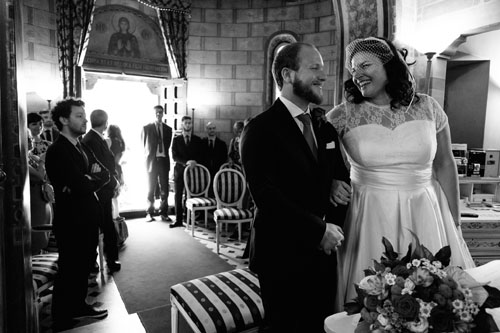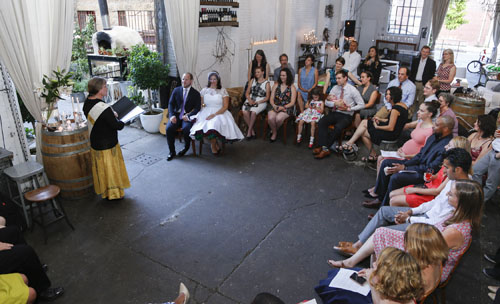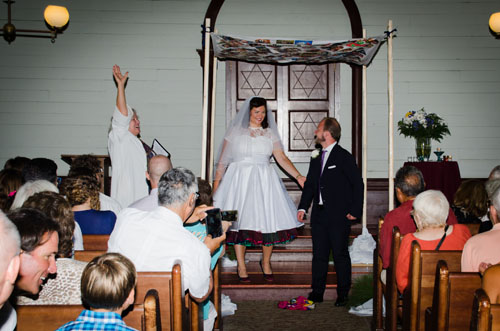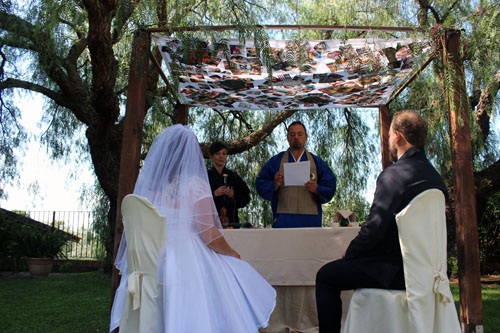By Jenn Lindsay
ROME, Italy — Two weeks after I met the man who would become my husband, we were sitting on the moonlit front porch of a house in Umbria, breathing in the fresh air of the Italian countryside. If we had been from the same country, we might have been nervous about our mysterious mutual understanding that our blossoming relationship could last a long time. But, since my summer in Italy was just a summer, we couldn’t think of the future. So we set aside pressures of longevity and leaned into the moment together. Side by side, we took in the moon, the crisp air, the creeping darkness of the nighttime garden in the neighbor’s yard.
I remember, under the cool glow of the moonlight, he looked at me and said, “It’s almost like you belong to every religion.” What a prescient remark, given that, four years later, we would have four different weddings all of distinct flavors and religions.
He had long ago left his native Catholicism and chosen to practice Zen Buddhism, while I, an anthropologist of religion committed to Reform Judaism since my early teens, also hold a Master of Divinity degree from a historically Protestant seminary, studied and practiced Vipassana Buddhism for several years, and followed my PhD fieldwork to Indonesia and the Middle East where I deepened my knowledge of—and affection for—the principles and practices of Islam.
At the end of that first summer we weren’t ready to say goodbye. Our instincts told us to stay in touch: after all, my research was bound to bring me back to Italy for longer stretches. I didn’t want to let go of my brilliant, silly, straightforward, feisty Italian. And he didn’t want to let go of his adventurous, affectionate American. One morning a few days before my departure, as the anxiety of our separation loomed, a steadying notion came to me. I said to him, Why don’t we plan a ritual? To mark our commitment to each other, to mark how we found each other and what we share, and why we choose to keep journeying together….
His enthusiasm for such a ritual was yet another clue to me, the consummate ritual nerd, that he might be the one.
With momentous seriousness we went about planning our commitment ceremony, writing our vows and choosing ritual elements. His Zen Buddhist practice offered elements of silence and a bell, candle and incense, and a verse chanted in Japanese. The verse was the Four Bodhisattva Vows, the fundamental vows of the Zen Buddhist path, expressing the bodhisattva’s resolution to attain awakening in order to liberate all sentient beings. My Jewish faith contributed the Shehecheyanu prayer—a prayer declaring joy in new beginnings—and a declaration of mutual love: ani le dodi v’dodi li. I am my beloved’s, and my beloved is mine.
We planned our ceremony as a picnic at Villa Celimontana, an emerald park in the heart of Rome, not far from the Colosseum. Under the watchful gaze of ancient marble busts and Roman palms, we blessed the candlelight with a Hebrew blessing and circled our picnic blanket seven times, an element of the Jewish wedding ceremony. The ritual—as idiosyncratic as it was—felt sacred and solemn. It linked us with a bond that felt unexplainably unbreakable. The magic of our ritual, even in its unauthorized, creative and spontaneous form, was transformative. Through ritual we anchored our tender inklings and sweet nothings onto something bigger than a summer romance.
We would have blushed to know that our robust little interfaith ritual would form the basis of our wedding ceremonies, four years later.
As our years together passed we reprised our ceremony every year on the same date in August, returning to our circles, our chanting, our candles and silence, our vows. Every year we re-exchanged our rings—two little shiny silver circles we bought for 40 euro on the eve of the first ritual.
After two years of Skyping and rushed reunions, my doctoral research enabled me to relocate to Rome. We moved in together, and after a few months he proposed, right on the spot where we had met, in front of the Portico d’Ottavia in Rome’s historic Jewish ghetto.
Of course, I accepted.
What sort of wedding could we assemble out of all our different worlds? His culturally Catholic family in Rome and his Zen Buddhist sangha; my Reformed Jewish community in Rome; my diverse family and formative friends in San Diego; my multicultural family-like assemblage of darling seminarians, philosophers, artists and atheists in New York City and Boston, whom I had befriended and beloved over 13 years on the East Coast. The more we thought about conflating all these worlds and rhythms into one giant party, the more overwhelmed we felt. It wasn’t the right option.
The logistical reality of clearing up my immigration status made the first step easy: we would get hitched legally at Rome’s city hall. In attendance would be his family and some friends from our Roman world; we’d enjoy a small lunch afterward at his parents’ home. As luck would have it, we were able to schedule our civil ceremony on July 16th, the day we had met four years prior at the Portico d’Ottavia.
The Rome municipal office confirmed our wedding date only a month shy of the ceremony itself, so there was no time to plan a larger ceremony and celebratory lunch. Neither was there time for my beloved friends and family to travel from the USA and be with us at city hall.
So we decided to take Mohammed to the mountain and we made a grand plan. After a city hall wedding in Rome, we would travel to New York City and hold a spiritual vows ceremony and celebration for our American East coast contingent. Then we would travel to San Diego and marry in a Jewish ceremony at Temple Beth Israel, the historic 1880s synagogue in Old Town. We would take a honeymoon camping trip, tenting in state parks through the Southern California deserts and driving North past Mount Whitney, through Yosemite, and out to the Pacific coastline. We would then return to Rome and hold our fourth and final wedding celebration, a Zen Buddhist ceremony marshaled by his Zen master and sangha members, and celebrate with our Roman world.

I don’t know what it’s like to get married in city hall in most cities. I picture a relatively unceremonious affair in plain government buildings, flanked by government employees in business casual dress. But Romans have a flair for the dramatic. Getting hitched in city hall in Rome means getting hitched in a deconsecrated chapel by an Italian state official sashed in the Italian tricolore. Our chapel, Villa Lais, was desacralized[1], but its golden mosaic shone down on our enormous ceremonial Italian marriage certificate, coating our union in a sacred glow. Our Roman friends and family gathered close in the tiny chapel, witnessing as my beau and I listened to the Italian municipal law regarding marriage, and as the state official asked us if we agreed. We were married with a resounding “si!” and a series of signatures from us and from our legal witnesses—his cousin Marco and my American friend Pamela. After the ceremony we enjoyed an intimate lunch at the family home, toasting our union with spumante and a delectable banana cream cake.

Jenn and Edoardo have a second wedding ceremony on August 7, 2016, in Brooklyn (Photo: Kevin Kane)
Two weeks later we packed our wedding clothes and flew to Brooklyn, where my dear friends Monica and Leisah of Roquette Catering hosted our wedding ceremony and festivities at their converted warehouse event venue Atelier Roquette. We used the template of our annual commitment ceremony to develop the ritual, and asked my dear friend Kathryn to officiate. Kathryn is an ordained Methodist deacon with whom I completed my Master of Divinity at Union Theological Seminary, and I knew she would be able to help us translate theological phrases and concepts into the right language for our spiritual ceremony.
A major change to our original ceremony—introduced to involve more beloved friends in the ritual itself—was inspired by the Jewish tradition of the Seven Blessings. Historically, seven standard Hebrew blessings are recited by friends and honored guests of the bride and groom. In some modern Reform Jewish ceremonies, seven honored guests are asked to write original English-language blessings in the spirit of the original blessings. So we were blessed by a succession of precious people, each one after the last drawing out more tears, laughter, and joy.
My friend Robin Aigner, a singer-songwriter I had played music and toured with for years, taught our 45 guests to sing “Lullaby” by the Dixie Chicks and we all joined in song together. Then Kathryn led us in a “chocolate communion” whereby we partook of Lindt’s chocolate truffles and contemplated the sweetness of life together. Then, led by Kathryn, we pronounced vows that we had adapted with her help from the Methodist service book. After we exchanged rings, audience members called out wishes and blessings for us, and the ritual concluded. The dancing then commenced. Need I say more? It was a perfect, perfect, perfect day.

A week later we boarded a flight for San Diego. We had reserved Beth Israel Temple and the adjacent Heritage County Park Lawn for the entire day. A longtime dear friend and craft quilter had been working for months to sew our chuppah, the wedding canopy meant to symbolize the future home of the couple, which was decorated with fabric-printed photographs of our lives, friends, families, beloved animals, and scraps of meaningful clothing. Because my man is a Buddhist, my childhood Conservative rabbi was not able to officiate at our interfaith simcha, so I was very happy to invite the wonderful Unitarian Universalist minister Laurel Liefert to bless our marriage and usher us through the ceremony, which used the same template as the Brooklyn wedding but was more formal, more loyal to traditional Jewish elements, and incorporated more components.
My old cross-country teammates from Grossmont High School showed up early in the morning to set up our big reception picnic. My oldest friends carried our chuppah down the aisle and met us at the front of the beautiful ol’-wild-west-saloon-style synagogue. My fellow choir singers from Grossmont High School gathered to sing together for the first time since Spring 1996, and our choir master Edwin Basilio directed us in song. I was led down the aisle of Beth Israel Temple by my father, stepping to sweet music played by Grossmont High School math teachers (and my old bandmates) Robert Ridgway and Jeremy Cooke. Reverend Laurel performed a blessing over the chalice candle [2], my man and I circled each other and the chuppah seven times, we received blessings from seven of our dearest friends, and the whole congregation together sang “Lullaby” by the Dixie Chicks.
As we sang together the breeze flowed through the open windows of the synagogue, cleansing us with fresh California air and sanctifying our vows. Reverend Laurel instructed the gathered congregation to say “Mazal Tov!” when my husband broke the glass. Their resounding cry concluded the ceremony and we flooded out to the lawn, where the Rasta Taco truck caterers were waiting to serve fish tacos, and our band Mariachi Real serenaded our entrance. We picnicked till dusk, the kids playing with our wedding favor frisbees, everyone munching on Cupcakes á la Yola.
After some weeks of camping throughout California, we returned to Rome. We spent evenings on our honeymoon cuddling at the campfire, roasting marshmallows and studying the Heart Sutra in preparation for reciting it during our Zen Buddhist ceremony. Because the weddings weren’t yet concluded: the fourth and final one, which we had taken to call our Romecoming, awaited us in our now shared hometown: the Eternal City.

Jenn and Edoardo recite vows at fourth wedding on Sept. 24, 2016, with Tiziana Crociani and Daishin Alfredo Malagodi officiating (Photo: Elena Varasi)
In mid-September, friends and family gathered at Lecanfore, an agriturismo (family-run farm resort) in rolling farmlands on the outskirts of Rome. We chose to gather under our chuppah one last time, now with Zen Master Daishin and Tiziana, a member of the Zen sangha. Tiziana marked the beginning of the ceremony with wooden blocks and the chimes of a singing bowl, and all four of us together embarked on three recitations in Italian: the Heart Sutra, a meditation on interdependence and impermanence; the vows of refuge in the Three Jewels of Buddhism—the Buddha, the teachings, and the Zen community; and a recitation of Commitments to acceptance, solidarity, sincerity, justice, freedom, and respect for all living beings.
My man and I exchanged cups of sake and meditation bracelets. Master Daishin explained to our friends and family the significance of the chuppah and the elements of the Zen ceremony, as our gathered Italian guests were most familiar with Catholic sacraments and needed some explanation in order to fully appreciate the Zen and Jewish elements. After a brindisi (toast) we gathered around banquet tables for an aperitivo for which the hosts had prepared flutes of spumante, a Colosseum of cheese and a Vesuvius of prosciutto[2]. After we ate for a while, we filed in to the dining hall for a long, many-coursed meal, which culminated with another toast and the cutting of the cake—a millefoglie decorated with cake toppers we had collected in the USA. If that sounds like a lot of food, you’re right: after all, this was not only a Zen wedding but also Italian.
It was perfect that our fourth and final wedding was in Rome sweet Rome where we share a home. Our Zen ceremony completed the circle of our four weddings, bringing us back to the beginning, just as our original commitment ceremony does, every year in late August.
We had four weddings to consummate our one marriage. I don’t know what it would be like to just have one. We feel very fortunate to have friends and family who made it possible, who celebrated us in each place with great helpfulness and support. Each wedding—civil, spiritual, Jewish, and Zen Buddhist—felt profound and distinct and equally necessary. I’m relieved we didn’t have to cram it all into one day. Our wedding memories are now as rich and varied as life itself. The weddings themselves were interdependent, and yet also impermanent: our wedding season has now passed and we are on to the lovely business of enjoying our life together.
And, come next August, we will renew our vows again. L’chaim!
*
[1] I do not know the the ritual for desacralization but imagining the possibilities has provided me a great source of entertainment.
[2] Not the Jewish part of the wedding.
*
Jenn Lindsay, who grew up in San Diego, is now researching in Rome for her doctorate in religion from Boston University.